Itinerary edited by SAPIENZA UNIVERSITY OF ROMA 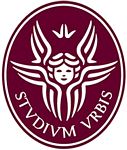

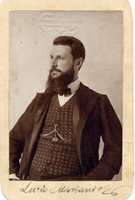

Born in Rome on 4th August 1865 to a family dedicated to art: both his parents were painters, in particular his father Cesare, who was the author of numerous frescoes in different churches and public places in Rome. After completing his studies at the E. Q. Visconti Secondary School with honours, he initially enrolled at the faculty of Law, graduating in 1888 with a dissertation on the condition of Jews in Rome. In the meantime, he also attended a series of other courses, indicating that during this early period of studies he had already developed an interest in antiquities. This led him to enrol at the Facoltą di Lettere e Filosofia, where he graduated in 1890 with a dissertation on the Cyclopean walls of Cori.
After travelling to Germany and Switzerland, in 1891, together with Luigi Savignoni and Giovanni Patroni, he won 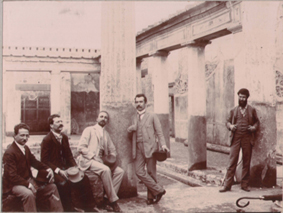 a competition to study at the Royal School of Archaeology, where he was taught by Emanuel Löwy and Rodolfo Lanciani. Over the next few years he was active as a student in Rome, Pompeii and Athens. As part of his study courses, he completed a series of activities in museums, of which a report on the museum of Corneto-Tarquiniais conserved in the family archive.
a competition to study at the Royal School of Archaeology, where he was taught by Emanuel Löwy and Rodolfo Lanciani. Over the next few years he was active as a student in Rome, Pompeii and Athens. As part of his study courses, he completed a series of activities in museums, of which a report on the museum of Corneto-Tarquiniais conserved in the family archive.
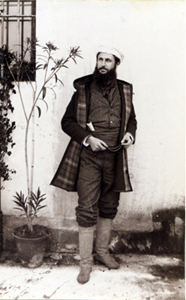
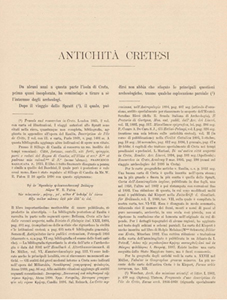
In August 1893, upon concluding his studies in Athens, he moved to Crete to collaborate with the Italian mission on the island, undertaken by Federico Halbherr. He remained there for three months and dedicated himself to a series of archaeological explorations on different sites throughout the island as well as the study of previously discovered material. The results were published in the volume Antichitą Cretesi, containing descriptions of the different sites he visited and, for the first time, an analysis of the ceramic class of the vases of Kamares.
Upon returning to Italy, he was entrusted with the completion of works on fideicommissum galleries and the supervision of museum collections in Modena and the Gallery of the Ducal Palace in Venice. In January 1895 he was hired by the Museo Nazionale Romano, for which he drafted the catalogue, together with Dante Vaglieri. A few months later he became a member of the Municipal Archaeological Commission.
In 1896 he was appointed vice-inspector of Museums, Galleries and Antiquity Excavation sites. He was also involved in the preparation of the magazine Notizie degli Scavi d'Antichitą.
His University career began in 1897, as professor by special appointment of Archaeology at the University of Pavia. From the outset he was determined to ground his teachings in the relationship between archaeology and art history, proving that he had assimilated the teachings of Löwy.
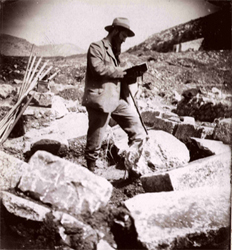 Between 1897 and 1902 he dedicated himself to the excavations of Alfedena (AQ), where the ancient Sannite Aufidena had once been located. Initially, he was entrusted with the task of organising material discovered during previous excavations by Antonio De Nino. Later he undertook new excavations in that place, and both new necropolis and a series of buildings around the acropolis on Monte Curino were brought to light. The results of these campaigns were included in the monograph Aufidena: ricerche storiche ed archeologiche nel Sannio settentrionale.
Between 1897 and 1902 he dedicated himself to the excavations of Alfedena (AQ), where the ancient Sannite Aufidena had once been located. Initially, he was entrusted with the task of organising material discovered during previous excavations by Antonio De Nino. Later he undertook new excavations in that place, and both new necropolis and a series of buildings around the acropolis on Monte Curino were brought to light. The results of these campaigns were included in the monograph Aufidena: ricerche storiche ed archeologiche nel Sannio settentrionale.
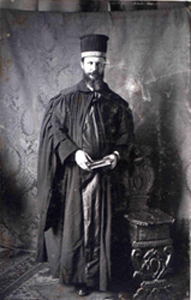
In April 1900 he left the University of Pavia for the same tenure at the University of Pisa, where in 1901 he was promoted to full professor. He remained at the University of Pisa until 1914. He was Head of Faculty twice, while maintaining his commitments with the Municipal Archaeological Commission. He published a series of articles on the Commission's bulletin, regarding the most important archaeological discoveries in Rome.
In 1904 he became a member of the Accademia di S. Luca, and in 1913 he became secretary. In 1908 he became a corresponding member of the Accademia dei Lincei and from 1912 to 1919 he was a member of the Supreme Council for Antiquities and Fine Arts. He was also one of the founders of the Societą Italiana di Storia e di Archeologia (Italian Society of History and Archaeology), as well as editor of the magazine Ausonia, published between 1907 and 1921 and focused on archaeology and art history.
In February 1913 Mariani became part of the directorate of the archaeological service of the Ministry of Colonies, entrusted with coordinating the works of archaeologists present throughout the lands, including Salvatore Aurigemma and Ettore Ghislanzoni, as well as the presentation of the results of their excavations to the Italian archaeology community. He also travelled to Africa to supervise restoration works of the arch of Marcus Aurelius in Tripoli and the inauguration of local museums. The family archive contains a series of documents regarding this period of Mariani's activity, including a draft of a manual of colonial archaeology.
When Italy entered the First World War and with Löwy's consequent departure for Austria, the Archaeology and Art History chair at La Sapienza University in Rome was assigned to Mariani who was a substitute from 1915 to 1918. His transfer as full professor to Rome was ratified.
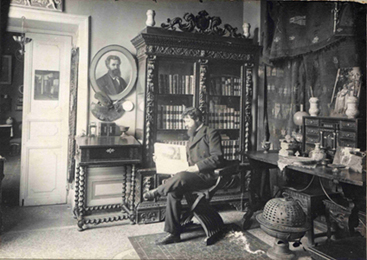
From 1915 Mariani was director at the Museo dei Gessi, at the Capitoline Museums and the Barracco Museum. During this period, he also held prestigious positions in the Municipality of Rome.
In April 1919 Mariani travelled to Tripoli to supervise the inauguration of the local museum. The early symptoms of lethargic encephalitis first appeared upon his return to Italy. This disease claimed his life in 1924.
Mariani's wide scientific production ranges from ancient art history to on-field archaeological research, prehistory, protohistory and classic history. It is essential to study his complexity as an academic and his intense institutional activities in greater detail, promoted and examined within the context of the cultural conditions of his time.
1865 Birth
1888 Law Degree
1890 Art Degree
1893 Archaeological exploration on the island of Crete
1893 Graduation from the Royal School of Archaeology
1895 He was appointed assistant at the Museo Nazionale Romano
1895 He was appointed member of the Municipal Archaeological Commission
1895-96 Collaboration for the refurbishment and reorganisation of the Modena Gallery and the Archaeological Museum of Venice
1895 He was appointed Vice inspector of museums, galleries and excavations
1898 Temporary professor of Archaeology at the University of Pavia
1900 Transfer, same tenure, to the University of Pisa
1897-1901 Excavation at Alfedena
1901 Promoted to Full Professor
1903-04 He was appointed Head of the Facoltą di Lettere e Filosofia
1908 He was appointed corresponding member of the Accademia dei Lincei
1912 He was appointed Head of the Facoltą di Lettere e Filosofia
1912 He was appointed member of the Supreme Council of Antiquities and Fine Arts
1913 He worked for the Ministry of Colonies
1915-18Substitute Full Professor of Archaeology and Art History at the University of Rome
1916 He was appointed Director of Municipal Archaeological Services of the Rome Municipality
1918 He was appointed Full Professor at the University of Rome
1924 Death
 Tarquinia
Tarquinia  Pompei
Pompei  Atene
Atene  Creta
Creta  Modena
Modena  Venezia
Venezia  Naples
Naples  Capua
Capua  Brindisi
Brindisi  Pavia
Pavia  Pisa
Pisa  Alfedena
Alfedena  Tripoli
Tripoli  Ain Zara
Ain Zara  Zliten
Zliten  Leptis Magna
Leptis MagnaBibliography collected in: Mazzocco L. (2008). Mariani, Lucio. In 70: Dizionario biografico degli italiani (Bibliographic Dictionary of Italians) (p. 296-298). Rome: Istituto della Enciclopedia italiana (Institute of the Italian Encyclopaedia).
Archive funds: Roma, Archivio della famiglia Mariani; Ibid., Archivio Centrale dello Stato, Ministero della Pubblica Istruzione, Fascicoli personali dei professori ordinari, II versamento, serie I, b. 90, f. Lucio Mariani; Archivio storico della Sapienza Universitą di Roma, f. 130, Lucio Mariani; Archivio del Museo dell’Arte Classica, Sapienza Universitą di Roma; Archivio Storico Capitolino, Ripartizione X - Antichitą e Belle arti, anno 1917, b. 17, n. 3; anno 1918, b. 4, n. 2; Appendice, aa. 1921-31, b. 308, n. 1; Commissione archeologica, bb. 29, n. 1360; 32, n. 18; 37, nn. 492, 4, 43, 83; 32, n. 114 bis; 38, n. 66; Roma, Archivio storico dell’Accademia di S. Luca, voll. 189, nn. 115, 120; 190, n. 1; anno 1913, atto n. 7860; Ibid., Biblioteca Angelica, Barnabei, b. 301/1; Gnoli, b. 95/4; Archivio di Stato di Pisa, Universitą di Pisa, III vers., f. 330.